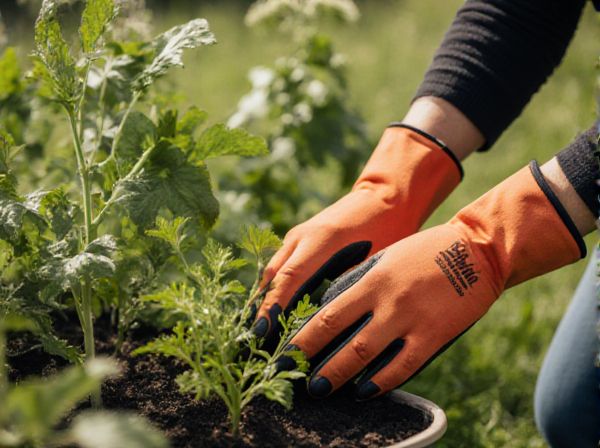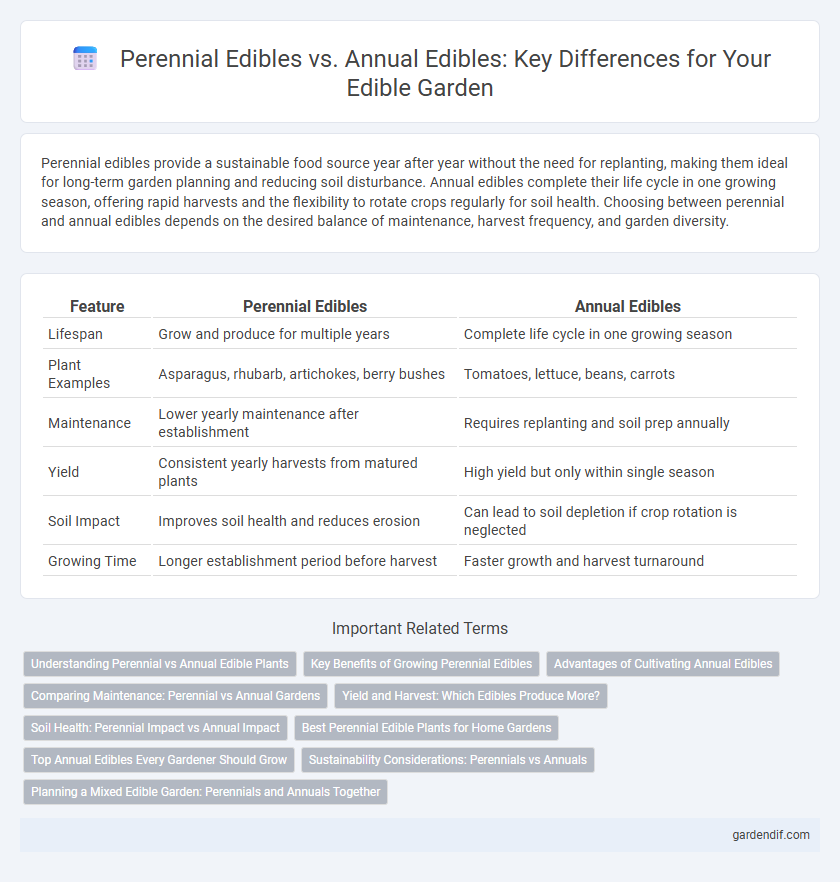
Perennial edibles vs Annual edibles Illustration
Perennial edibles provide a sustainable food source year after year without the need for replanting, making them ideal for long-term garden planning and reducing soil disturbance. Annual edibles complete their life cycle in one growing season, offering rapid harvests and the flexibility to rotate crops regularly for soil health. Choosing between perennial and annual edibles depends on the desired balance of maintenance, harvest frequency, and garden diversity.
Table of Comparison
| Feature | Perennial Edibles | Annual Edibles |
|---|---|---|
| Lifespan | Grow and produce for multiple years | Complete life cycle in one growing season |
| Plant Examples | Asparagus, rhubarb, artichokes, berry bushes | Tomatoes, lettuce, beans, carrots |
| Maintenance | Lower yearly maintenance after establishment | Requires replanting and soil prep annually |
| Yield | Consistent yearly harvests from matured plants | High yield but only within single season |
| Soil Impact | Improves soil health and reduces erosion | Can lead to soil depletion if crop rotation is neglected |
| Growing Time | Longer establishment period before harvest | Faster growth and harvest turnaround |
Understanding Perennial vs Annual Edible Plants
Perennial edible plants, such as asparagus and rhubarb, live and produce harvestable food for multiple years, reducing the need for annual replanting and providing sustainable yields. Annual edible plants like tomatoes and lettuce complete their life cycle within a single growing season, requiring new planting each year but offering faster harvest and crop rotation benefits. Understanding the differences between perennial and annual edibles helps optimize garden planning for long-term productivity and resource efficiency.
Key Benefits of Growing Perennial Edibles
Perennial edibles offer key benefits such as reduced planting time and lower maintenance efforts, delivering continuous harvests over multiple seasons. These plants improve soil health by enhancing microbial activity and preventing erosion, supporting sustainable gardening practices. Growing perennials also decreases resource consumption like water and fertilizers, making them an eco-friendly choice for home gardeners and commercial growers alike.
Advantages of Cultivating Annual Edibles
Annual edibles offer rapid growth cycles that enable multiple harvests within a single year, maximizing food production efficiency for home gardeners and commercial farms alike. Their shorter growing periods allow for seasonal crop rotation, reducing soil nutrient depletion and minimizing pest and disease buildup. Cultivating annual edibles also provides greater variety and flexibility in crop selection, supporting diverse diets and adapting quickly to changing climatic conditions.
Comparing Maintenance: Perennial vs Annual Gardens
Perennial edibles such as asparagus and rhubarb require lower maintenance once established, with fewer plantings needed each year compared to annual edibles like tomatoes and lettuce, which demand regular replanting and more intensive soil preparation. Annual gardens often involve continuous watering, fertilizing, and pest control throughout the growing season, whereas perennials typically need seasonal pruning and less frequent nutrient replenishment. This difference in maintenance impacts time investment and long-term garden planning, making perennials more sustainable for low-effort edible gardening.
Yield and Harvest: Which Edibles Produce More?
Perennial edibles, such as asparagus and fruit trees, typically yield crops year after year without replanting, offering a consistent and often larger cumulative harvest over time compared to annual edibles like tomatoes and lettuce that produce a single-season yield. Annual edibles can provide quicker, higher yields within one growing season, but require replanting each year, which may limit total long-term output. Growth conditions, crop type, and gardening methods greatly influence the overall yield and harvest frequency between perennial and annual edible plants.
Soil Health: Perennial Impact vs Annual Impact
Perennial edibles enhance soil health by developing deep root systems that improve soil structure, increase organic matter, and promote microbial diversity over time. Annual edibles, with their short life cycle, often lead to repeated soil disturbance, which can result in erosion, nutrient depletion, and reduced microbial activity. Integrating perennials into cultivation systems supports long-term soil fertility and stability, contrasting with the more transient impact of annual crops.
Best Perennial Edible Plants for Home Gardens
Perennial edible plants such as asparagus, rhubarb, and artichokes provide sustained harvests year after year, reducing the need for replanting and offering long-term yield benefits in home gardens. Unlike annuals, which complete their life cycle in a single growing season, perennials establish deep root systems that improve soil health and resilience. Incorporating perennial edibles into home gardens maximizes space efficiency and delivers reliable, nutrient-rich produce with less maintenance over time.
Top Annual Edibles Every Gardener Should Grow
Top annual edibles every gardener should grow include tomatoes, lettuce, and beans, known for their quick growth and high yield within a single growing season. These crops provide fresh, nutrient-rich produce ideal for summer gardens, requiring replanting annually to maintain continuous harvests. Prioritizing annual herbs like basil and cilantro enhances culinary diversity while offering fast turnover compared to perennial edibles.
Sustainability Considerations: Perennials vs Annuals
Perennial edibles offer sustainable advantages by reducing soil disturbance and promoting long-term soil health through extensive root systems that prevent erosion and enhance nutrient cycling. Annual edibles require yearly tilling and replanting, which can deplete soil nutrients and increase carbon emissions due to frequent cultivation and input use. Integrating perennial crops into garden or farm systems supports biodiversity, conserves water, and decreases reliance on synthetic fertilizers and pesticides compared to solely growing annual edibles.
Planning a Mixed Edible Garden: Perennials and Annuals Together
In planning a mixed edible garden, combining perennial edibles like asparagus and rhubarb with annuals such as tomatoes and lettuce maximizes harvest diversity and extends production throughout the growing season. Perennials provide consistent yields year after year with minimal replanting, while annuals offer seasonal variety and quick turnover for continuous fresh produce. Integrating both types optimizes garden space, soil health, and resource efficiency, creating a sustainable and productive edible landscape.
Perennial edibles vs Annual edibles Infographic

 gardendif.com
gardendif.com